INSTRUCTION TO CANDIDATES
- This paper consists of two Sections A and B.
- Answer all the questions in sections A and B in the spaces provided.
- Mathematical tables and electronic calculators may be used.
SECTION A (25 MARKS)
- The figure shows the reading of micrometre screw gauge that has a zero error of -0.25mm. What is the actual length of the object being measured (2marks)
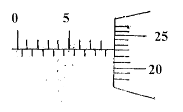
- The figure below shows a matchstick soaped on one end and placed on the surface of clean water as shown.
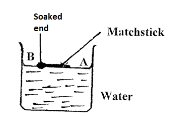
The matchstick is observed to move towards a certain direction- State the direction (A or B) (1mark)
- Explain (1mark)
- Two liquid X and Y have density 1.25g/cm3 and 1.5g/cm3 respectively. Calculate to 2d.p the density of the mixture containing 40% by mass of X the rest being Y (3marks)
- A uniform meter rule pivoted at its 15cm mark is balanced by a 200g mass suspended at the 5cm mark. Determine the weight of the meter rule (3marks)
- A paper windmill in a horizontal axis was placed about a candle as shown in the figure

When the candle was lit the paper windmill began to rotate. Explain this observation. (2marks) - An object was placed on an inverted bowl as shown.
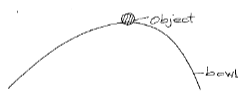
- State the type of stability above. (1mark)
- Define the type stability above. (1mark)
- A pipe of diameter 12mm is connected to another pipe of radius 9mm. if water flows in the wider pipe at the speed of 2m/s what is the speed in the narrow pipe. (3marks)
- A car starting from rest accelerates uniformly for 5minutes to reach 30m/s. It continues at this speed for the next 20minutes and then decelerates uniformly to come to stop in 10 minutes. On the axes provided sketch the graph of velocity against time for the motion of the car (1mark)
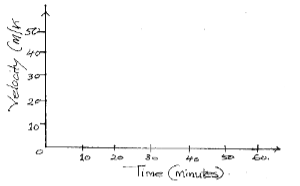
- A diver was swimming in a swimming pool of uniform depth of 0.8m from the surface of water. If atmospheric pressure acting on the surface of water is 103000pa calculate the total pressure experienced by the diver. (density of water = 1g/cm3, g= 10m/s2) (2marks)
- The boiling point of water is known to be at 100oC. A student heated some water and noticed that it boiled at 101oC state two possible reasons for this observation. (2marks)
- Explain the difference between a liquid and a gas in terms of intermolecular distance and force. (2marks)
- State the source of energy for gases in the atmosphere. (1mark)
SECTION B 55 MARKS
-
- Define the term velocity ratio of a machine (1mark)
- Figure below shows part of a hydraulic press. The plunger is the position where effort is applied while the ram piston is the position where load is applied. The plunger has a cross-section area a m2 while the ram piston has a cross-section area Am2
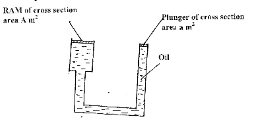
When the plunger moves down a distance d, the ram piston moves up a distance d.- State the property of liquid on which the working of the hydraulic press works (1mark)
- Derive an expression for the velocity ratio (V.R) in terms of A and a (3marks)
- A machine of velocity ratio 45, overcome a load of 4.5×103N, When an effort of 135N is applied.
Determine- The efficiency of the machine (3marks)
- The percentage of work that goes to waste (1mark)
-
- Define specific latent heat of fusion of a substance (1mark)
- Water of mass 200g at a temperature of 60oC is put in a well lagged copper calorimeter of mass 80g. A piece of ice at 0oC and mass 20g is placed in the calorimeter and the mixture stirred gently until all the ice melts. The final temperature T of the mixture is then recorded. (Take; specific latent of fusion of ice=334000J/kg, s.h.c of water =4200j/kg-1k-1, s.h.c of copper =900J/kg-1k-1
Determine:- The heat absorbed by the melting ice at 0oC (1mark)
- The heat absorbed by the melted ice (water) to rise to temperature T. (answer may be given in terms of T) (2marks)
- The heat lost by the warm water and the colorimeter (answer may be given in terms of T) (2marks)
- The final temperature of the mixture (3marks)
-
- State Newton’s second law of motion (1mark)
- A matatu starts from rest and accelerates to cover a distance of 49m in 7seconds. Determine its acceleration. (2mks)
- A trolley moving on a horizontal bench of height 1.2m strikes a barrier at the edge of the bench. The brass mass on the top of the trolley flies off on impact and lands on the ground 2.5m from the edge of the bench. Determine
- The time taken by the brass mass to reach the ground. (2marks)
- The speed at which the trolley struck the barrier (2marks)
- A passenger dropped a coin held at his hands in a stationary bus and it landed at his feet. State and explain the position it will land if he repeat it once again and the bus was assumed to be moving in a straight line at constant speed (2marks)
- Figure below shows of mass 4kg immersed in liquid and suspended from a spring balance with a string. The beaker was placed on a compression balance and shown the reading of 85N. The density of the stone was 3000kg/m3 while the density of the liquid was 800kg/m3
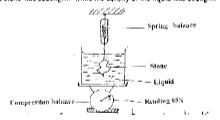
- State Archimedes principle (1mark)
- Determine
- Volume of the liquid displaced (2marks)
- Up thrust on the stone (2marks)
- Reading of the spring balance (2marks)
- Find the volume of hydrogen gas filled balloon that will carry a 300kg load in air (density of air =1.3kg/m3 while that of hydrogen =0.9kg/m3) (3marks)
-
- State Boyles law (1mark)
- State the measurements taken in verifying the law above (2marks)
- Explain how measurement above are used to verify Boyles law. (3marks)
- At 30oC, pressure of a gas is 60cmHg. At what temperature would the pressure of the gas rise to 100cmHg if the volume is kept constant. (3marks)
-
- A car of mass 1500kg moves round a circular track of radius 1200m at a constant speed of 20m/s what is the centripetal force action on the car. (3marks)
- The figure below shows a stone of mass 10kg being whirled using a rope in a vertical circle of radius 2.5m
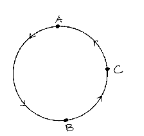
State what provides the centripetal force at points.- A (1mark)
- B (1mark)
- C (1mark)
- Calculate the maximum tension on the body if it was moving ate a linear velocity of 10m/s. (g=10m/s2)
(3marks)
MARKING SCHEME
- reading = 8.72mm 1mk
1mk -
- B (1mk)
- Explanation: soap dissdues and lower surface tension around B force at A is high than that at B, resultant force between A and B makes the stick move towards B
- Let total mass=100
mass of x = 40/100 x 100 = 40g
mass of y = 60/100 x 100 = 60g
volume of x = 40/1.25 = 32g
volume of y = 60/1.5 = 40g
velocity = 100/32140 = 100/72 = 1.3888 = 1.389g/cm3 or 1389kg/m3 
clockwise moment = anticlockwise moments
(0.35) × w = 2(0.1)
W = 0.2/0.35 = 0.5714- Flame heat the surrounding air which expands, becomes les dancer and rises. The cold les denser air descend to occupy the space of the heated air. This process continuously producing convention current which drives continuous the windmill
-
- unstable
- If an object is slightly displaced its C.O.G is lowered end continues to move away from its original position✔1
- A1V1 = A2V2
= 22/7 x 6 x 6 (V) = 22/7 x 9 x 9 x 2
= 9 x 9 x 2
6 x 6
= 4.5m/s 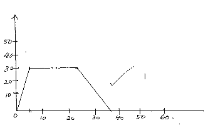
- Total pressure = atmospheric pressure + water pressure
Water pressure = ρhg = 1000 x 10 0.8 = 8000 -
- presence of impurity
- Increase in pressure
-
- intermolecular distance are larger / longer in gases than in liquid
- Force of attraction in liquid are stronger / greater than in gases
- sun
Section B
-
- is a ratio of the distance moved by the effort to distance moved by the load.
-
- pressure at one point of an enclosed liquid is equally transmitted to all other part of the encased liquid.
- Vol of liquid leaving plunger = vol of liquid entering the piston
a x d = A x D
d/D = A/a = V.R
V.R = A/a
-
- M.A = 4.5 x 103 = 33.33
135
ρ = M.A x 100 = 33.33 x 100 = 74.07%
V.R 45 - % of work wasted = 100-74.07
= 25.93%
- M.A = 4.5 x 103 = 33.33
-
- it is the quantity of heat required to change the state of a unit mass of a substance from solid to liquid without temperature change.
-
- Q = Mlf
= 0.02 x 33400
= 668J - Q = MCΔθ
= 0.02 x 4200 x (T - o)
= 84 T - MaCwΔ + McCcΔθ
= 0.2 x 4200 x (60 - T)0.8 x 900 x (60-T)
= 54720 - 912T
T = 48040 = 48.23ºC
996 - heat lost by warm water +calorimeter =heat absorbed by melting and malted ice
- Q = Mlf
-
- The rate of change of momentum of a body is directly proportional to resultant external force producing the change and takes place in the direction of force.
-
s = ut + 1/2 at2
49 = 0 + 1/2 x a x 72
a = 2m/s2 -
- h = 1/2 gt2
= 1.2 = 1/2 x 10 x t2
t2 = 1.2/5
t = 0.9s
- R = ut
2.5 = u x 0.49
u = 5.102 m/s
- h = 1/2 gt2
- Still at his feet both passenger and the coin curry the same horizontal distance
-
- when a body is fully or partially immersed in a fluid it experiences an up thrust which is equal to the weight of the fluid displaced
-
- V = mass of stone = 4 x 1.3333 x 103
density of stone 300 - u = weight of liquid displaced = vρg
8000 x 1.333 x 10-3 x 10
10.6664N - R = weight in air - upthrust
= 4 x 10 - 10.6664
= 29.44446
- V = mass of stone = 4 x 1.3333 x 103
- up thrust =weight of wood + weight of hydrogen
-
- For a mixed mass of a gas, pressure in inversely proportional to volume at a constant temperature
-
- volume of air/ gas
- pressure of the gas
-
- initial values of volume and corresponding values of pressure was recorded
- Several values of volume and pressure were tabulated
- Values of from the table were calculated
- The graph of P against was plotted the graph is a straight line indicating that pressure inversely proportional to volume
P1 = P2
T1 P2
T2 = P2T1
P1
= 100 X 303
60
= 505K or 232°C
-
- F = mv2
r
F = 1500 x 20 x 20
1200
= 500N -
- At A the sum of tension and weight of the body.(T+mg)
- At B difference between tension and weight of thr body (T – mg)
- At c tension of the rope
- T = Mr2 + mg
r
= 10 x 10 x 10 + 10 + 10
2.5
= 400 + 100
= 500N
- F = mv2
Join our whatsapp group for latest updates
Tap Here to Download for 50/-
Get on WhatsApp for 50/-
Download Physics Paper 1 Questions and Answers - Cekana Mock Exams 2023.
Tap Here to Download for 50/-
Get on WhatsApp for 50/-
Why download?
- ✔ To read offline at any time.
- ✔ To Print at your convenience
- ✔ Share Easily with Friends / Students
